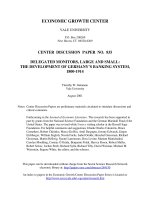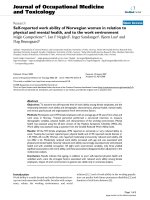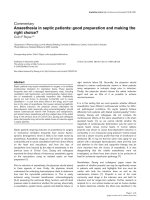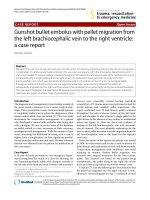E-CONOMY SEA 2019: SWIPE UP AND TO THE RIGHT: SOUTHEAST ASIA’S 100 BILLION INTERNET ECONOMY
Bạn đang xem bản rút gọn của tài liệu. Xem và tải ngay bản đầy đủ của tài liệu tại đây (8.28 MB, 65 trang )
1
Reference
e-Conomy SEA is a multi-year research program launched by Google and Temasek in 2016. Bain &
Company joined the program as lead research partner in 2019. The research leverages Bain analysis,
Google Trends, Temasek research, industry sources and expert interviews to shed light on the Internet
economy in Southeast Asia. The information included in this report is sourced as “Google & Temasek /
Bain, e-Conomy SEA 2019” except from third parties specified otherwise.
Disclaimer
The information in this report is provided on an “as is” basis. This document was produced by and the
opinions expressed are those of Google, Temasek, Bain and other third parties involved as of the date
of writing and are subject to change. It has been prepared solely for information purposes over a limited
time period to provide a perspective on the market. Projected market and financial information, analyses
and conclusions contained herein should not be construed as definitive forecasts or guarantees of future
performance or results. Google, Temasek, Bain or any of their affiliates or any third party involved makes
no representation or warranty, either expressed or implied, as to the accuracy or completeness of the
information in the report and shall not be liable for any loss arising from the use hereof. Google does not
provide market analysis or financial projections. Google internal data was not used in the development
of this report.
2
Content
Executive summary 4
Introducing e-Conomy SEA 2019 6
Mobile Internet is transforming Southeast Asia 8
The Internet economy hits $100 billion 13
Fast and faster: two-speed Southeast Asia 17
Growth opportunities beyond Metros 27
Fundamental changes in consumer behavior 31
Time is money: competing for engagement 41
Digital Financial Services reach the inflection point 44
Funding remains healthy despite global headwinds 51
Ecosystem challenges are being resolved 59
Appendix 62
3
Executive summary
Mobile Internet transforming Southeast Asia. Just over a decade ago, four in five Southeast Asians
had no Internet connectivity and limited access to the Internet. Today, Southeast Asians are the most
engaged mobile Internet users in the world. There are 360 million Internet users in the region and
90% of them connect to the Internet primarily through their mobile phones.
They communicate with their families, friends and colleagues, entertain themselves, learn new skills and
become more productive. Increasingly, they also buy products, plan trips and order food online. All of this
takes place millions of times every day across the region. A vision that was almost impossible to imagine
is now daily routine.
Southeast Asia’s Internet economy hits $100 billion. Powered by these fundamental changes in
consumer behavior, the Internet economy continues to grow at an unprecedented pace. It has soared
to $100 billion for the first time in 2019, more than tripling in size over the last four years. e-Commerce
and Ride Hailing continue to beat the most optimistic of predictions. Online Media and Online Travel
keep growing at a steady rate, with ample room to expand further. By 2025, the Internet economy
is expected to grow to $300 billion.
Fast and faster growth: dual-speed Southeast Asia. The Internet economies in Malaysia, Thailand,
Singapore and the Philippines are growing by between 20% and 30% annually, with no signs of slowing
down. This is a remarkable feat compared to other regions, but hardly the best showing in Southeast
Asia. The two pacesetters in the region are Indonesia and Vietnam, which lead the pack with growth
rates in excess of 40% a year.
Time is money: competing for user engagement. Companies are switching their focus from acquiring
new customers to driving engagement. Their goal is to convince users to stay on their platforms for longer,
in the belief that purchases will follow. Vying for user engagement, companies have expanded their scope
across sectors, moving into new services, gamifying promotions and streaming enticing content. This has
ignited more intense competition, while providing users with more choices and lower prices.
Growth opportunities beyond Metros. The growth of the Internet economy has yet to spread
evenly across Southeast Asia. Seven Metropolitan areas, which house just 15% of the region’s
population, still account for more than 50% of the Internet economy. On average, people living in these
Metro areas buy six times more online than those living elsewhere. The Internet economy, however, has
the potential to grow twice as fast in areas outside the big cities, bringing all Southeast Asians on board.
4
Digital Financial Services reach the inflection point. The adoption of Digital Payments has finally
reached the inflection point and is expected to cross $1 trillion by 2025, accounting for almost one in every
two dollars spent in the region. Other Digital Financial Services are still nascent but gaining traction. These
technology-enabled business models are best positioned to give Southeast Asia’s underbanked population
access to Financial Services. While new entrants and established players are competing and partnering
to tackle this opportunity, supportive regulations will play a critical role.
Funding remains healthy despite global headwinds. More than $37 billion of capital has flowed into the
Internet economy over the last four years. While the majority has gone to e-Commerce and Ride Hailing
Unicorns, investments in nearly 3,000 startups in the region remain sizable. A growing cadre of “Aspiring
Unicorns” has emerged and is on the lookout for late-stage funding to scale further. Regional and global
investors are geared up for this opportunity, ready to back companies for longer and with more resources.
Ecosystem challenges are being resolved. Southeast Asia has made progress in overcoming the initial
roadblocks in the Internet economy. Internet access is now affordable for large segments of the population
and consumer trust in digital services has improved significantly. e-Commerce logistics, once a challenge,
has turned into a business opportunity for both startups and established players. Digital Payments are
rapidly spreading online and offline. But talent remains a pressing constraint despite all efforts by Internet
economy companies to “fill the gap”.
5
Introducing
e-Conomy SEA 2019
6
e-Conomy SEA is a multi-year research program launched to shed light on the Internet economy
in Southeast Asia. It covers the six largest markets in the region: Indonesia, Malaysia, the Philippines,
Singapore, Thailand and Vietnam. The 2019 report covers five key sectors of the Internet economy:
Online Travel (Flights, Hotels, Vacation Rentals); Online Media (Advertising, Gaming, Subscription Music
and Video on Demand); Ride Hailing (Transport, Food Delivery); e-Commerce; and a first in the series,
Digital Financial Services (Payments, Remittance, Lending, Investment, Insurance).
The series kicked off in May 2016 with the inaugural “e-Conomy SEA — Unlocking the $200 billion digital
opportunity in Southeast Asia”. In that report, we projected that the Southeast Asian Internet economy
would grow to $200 billion by 2025, fueled by rapid growth in Online Travel, e-Commerce and Online Media.
We also looked at the funding pipeline and concluded that investors had ample reason to be excited about
the region’s potential.
Since then, we have continued to track the growth of the Internet economy in the region closely,
expanding our coverage to more sectors and charting their progress. And we are constantly surprised
by how fast the Internet economy is growing. In last year’s report, “e-Conomy SEA 2018 — Southeast Asia’s
Internet economy hits an inflection point”, we noted that the economy had reached a turning point, which
would see gears shift. Investors have been moving funds into the region since, resulting in billion-dollar
investments into companies, talent and infrastructure.
This year’s report, “e-Conomy SEA 2019 — Swipe up and to the right: Southeast Asia’s $100 billion Internet
economy”, shows that the Internet economy has, for the first time, crossed the $100 billion mark. The pace
of growth has been unprecedented, leading to a revision of our own estimates.
This and previous reports would not have been possible without the assistance of industry experts who
have contributed to the research. In particular, teams at Golden Gate Ventures, Monk’s Hill Ventures,
Openspace, Vertex Ventures, Wavemaker and Jungle Ventures helped provide insights on venture capital
investments in Southeast Asia.
7
Mobile Internet
transforming Southeast Asia
8
Home to some 570 million people, Southeast Asia’s largest economies comprising Indonesia, Malaysia,
the Philippines, Thailand, Vietnam and Singapore are among the fastest growing markets in the world.
Economic growth in the region has averaged 5% a year in the last five years1 and has exceeded the global
growth average by approximately 2 percentage points over the past decade. This is indicative of a stable
and rapidly developing region that is on its way to becoming a major economic powerhouse. By 2030,
Southeast Asia is expected to become the world’s fourth largest economic bloc.
1 World Bank 9
Another phenomenon is reshaping Southeast Asia’s fastest growing economies: a highly-connected
and Internet-enabled community has taken root in recent years and it is growing rapidly. A decade ago,
almost four in five Southeast Asians had no Internet connectivity and limited access to the information
superhighway. Today, Southeast Asians are the most engaged mobile Internet users in the world.
Number of The region added more than 10 million Internet users last year, bringing
Internet the total number of people connected to the Internet to 360 million in 2019.
The Internet user base is now 100 million larger than it was in 2015.
users added
since 2015
Many of the new additions were young users, aged 15 to 19. Supported by the region’s healthy
demographics, this savvy brigade is set to grow. Some 150 million Southeast Asians will turn 15 over the
next 15 years, which works out to be 10 million people joining the “mobile age” every year.2 They will enter
adulthood having grown up with a device that allows them to communicate with their friends and family,
work with classmates on school projects, entertain themselves with the latest games, videos and music,
and discover information that aids them in their studies. And as these waves of young, mobile and digitally
connected users move into their working lives, they will naturally become part of the Internet economy,
further fueling its growth.
In line with previous research findings, users in the region continue to be the most engaged in the
world, spending significantly more time on the mobile Internet than their global peers. According to the
Digital 2019 research by We Are Social and Hootsuite,3 Internet users in Thailand spent five hours and
13 minutes per day on the mobile Internet, more than those in any other country. Users from Indonesia, the
Philippines and Malaysia, who are connected to the mobile Internet for approximately four hours a day, are
also among the top 10 countries in the world by mobile Internet usage. The global average is three hours
and 13 minutes.
2 World Bank
3 Digital in 2019 - We are Social, Hootsuite 10
Be it first-jobbers living in Chiang Mai, white-collar professionals based in Hanoi or small business
owners residing in Singapore, the mobile Internet is transforming the lives of millions of Southeast
Asians by giving them unprecedented access to people, information and services. Throughout the day,
across both work and personal activities, Internet services are making their lives more convenient and
productive than before.
For most users, social media and communication apps account for almost half of the time they spend on
the mobile Internet. Video apps follow close behind, with user engagement having doubled over the last
three years.4 Such apps have become the preferred companion for activities beyond just entertainment.
In Indonesia, where searches for “review” videos on YouTube grew by 40% in 2018,5 consumers use video
platforms to find the best products and services. Elsewhere in Thailand, one in three millennials say they
use YouTube to educate themselves on particular topics, and four in 10 mothers use the platform to learn
how to do specific things.6
4 App Annie analysis for e-Conomy SEA
5 “Year in Search: 2018 insights for brands”, Think with Google, Indonesia
6 YouTube/ORC International, YouTube Audience Insights Study, Thailand, 2018 11
Towards a more productive and purposeful use
Increasingly mindful about their financial needs, Southeast Asians are becoming more proactive when
it comes to considering which Financial Services are best for them. While Financial Services continue to
be primarily purchased offline, the influence of online research is growing. Research shows that 60%
of Singaporeans and 50% of Vietnamese did research online prior to purchasing Financial Services offline.7
That is not all. Some 72% of consumers in Indonesia see Google Search as the online gateway
for personal loan information and the second most helpful source of information for Financial Services,
after bank branches.8
Apps that help consumers locate places and businesses or suggest the best routes to destinations have
also become staples for many Southeast Asian users. Waze and Google Maps, for instance, use up-to-date
maps, real-time traffic information and public transport schedules to help millions of people save time
on their daily commutes. Such apps also serve as powerful tools for small and medium-sized businesses
(SMBs) in the region. They allow users to discover SMBs, check their locations and opening hours, contact
them to ask about their products and services, review and even book them, as in the case of many
restaurants and hotels.
At the same time, many Southeast Asians rely on cloud-based apps that are freely available and widely
trusted, such as Gmail, Google Docs and Google Sheets, to work more efficiently. These apps help SMBs
to cut costs, improve efficiency and boost collaboration. They allow employees to keep their work in one
secure place, as well as collaborate and share documents, spreadsheets and presentations with
teammates across devices.
In a region where 10 official languages coexist with hundreds of local dialects, apps like Google Translate
have become critical in bridging communication gaps, especially for users traveling in the region. Internet
browsers like Google Chrome as well as popular e-Commerce, Ride Hailing and Travel apps in Southeast
Asia use translation services to enhance communication in real time between users and service providers.
These are just some of the many ways in which the mobile Internet is transforming lives in Southeast
Asia. As most mobile Internet apps are free for use, they do not add to the monetary value of the Internet
economy sectors covered in this research, such as e-Commerce, Ride Hailing, Online Media and Online
Travel. However, their value to users and SMBs in the region cannot be understated.
7 “Rethinking search strategies for SEA consumers”, Think with Google, Southeast Asia, 2018
8 “Year in Search: 2018 insights for brands”, Think with Google, Indonesia 12
The Internet economy
hits $100 billion
13
The Southeast Asian Internet economy crossed a major inflection point in 2018. This year, it has continued
to surge on accelerating growth. Powered by rapid adoption and changing consumer preferences, it hit
yet another milestone: the $100 billion mark.
We estimate that the Southeast Asian Internet economy has leapt nearly 40% from last year to exceed
$100 billion in gross merchandise value (GMV) in 2019 across the Online Travel, e-Commerce, Online Media
and Ride Hailing sectors. With a 33% compounded annual growth rate (CAGR), the value of the Internet
economy has more than tripled between 2015 and 2019.
This pace of growth has exceeded all expectations. At this rate, the Southeast Asian Internet economy
is on track to hit $300 billion by 2025, topping our initial projection in 2016 by $100 billion.
Apart from spending more time on the mobile Internet, many are also spending money on online services
and products. The Internet economy now involves 180 million people in Southeast Asia, or about one
in two Internet users.
14
It is not just the penetration rate that stands out; the speed at which the region has adopted the
digital economy is also striking. Take e-Commerce as an example. In 2015, some 49 million people
bought or sold items online. Today, that number has tripled to 150 million people.
How fast the 5X Demand for Ride Hailing services has also exploded, with the number of
number of Ride active users ballooning five times to reach more than 40 million today,
Hailing users has from just eight million in 2015.
grown since 2015
Both e-Commerce and Ride Hailing, which includes Food Delivery services, are experiencing a burst
of demand as the result of both rapid adoption and fundamental shifts in consumer behavior. In the span
of a few years, e-Commerce and Ride Hailing have become an integral part of daily life for millions of
Southeast Asians, especially those living in big cities. They offer convenience, value and access to services
and products that were previously difficult to obtain.
For instance, the wide accessibility and affordability of Ride Hailing services in crowded Metropolitan
areas are prompting many Southeast Asians to rethink the need to own vehicles. Ride Hailing is a big draw
for people in crowded cities such as Bangkok, Jakarta and Kuala Lumpur, where private vehicle ownership
is costly, contributes to air pollution and is associated with frustrating jams.
Similarly, consumers are relying on Food Delivery services for meals they would otherwise have to
cook at home or buy from food vendors. For an emerging and increasingly time-conscious middle class,
the convenience of having piping hot food delivered to one’s doorstep is highly valued. Such consumer
behavior has become the norm, particularly among dual-income families.
15
As a key part of the Internet economy, e-Commerce marketplaces have long been around. But while
consumers used to go online sporadically for discounts on big-ticket items such as electronics, today’s
shoppers are turning to the Internet for more frequent purchases of lower-cost items, including
groceries, personal care and apparel. This means making multiple stops on e-Commerce sites and
shopping more regularly.
With all sectors taken into account, the GMV of the Internet economy amounted to 3.7% of Southeast
Asia’s gross domestic product (GDP) in 2019, up from 1.3% in 2015. It is projected to exceed 8% by 2025.
Southeast Asia is closing the gap with developed markets like the United States, where the Internet
economy had made up 6.5% of the GDP in 2016.9
9 US Bureau of Economic Analysis (BEA). 16
Fast and faster:
two-speed Southeast Asia
17
The Internet economy is thriving across all six Southeast Asian countries. But within this group of rockets,
speed is relative, with some taking off faster than the others. While the region has grown at an average
rate of 33% a year since 2015, Indonesia and Vietnam have pulled away from the pack, bolting ahead.
Size of Indonesia’s $130B Estimated at $40 billion in 2019, Indonesia’s Internet economy has
Internet economy more than quadrupled in size since 2015 at an average growth rate of
49% a year. As the largest and fastest growing Internet economy in the
by 2025 region, Indonesia is well on track to cross the $130 billion mark by 2025.
In particular, the e-Commerce and Ride Hailing sectors are firing on all
cylinders, fueled by intense competition between Indonesian and regional
players. All sectors are also benefiting from the growing adoption of
Digital Payments.
Investments have followed suit, with fewer but larger deals. This year, Indonesia is on track to match the
record established in 2018, when almost $4 billion was raised. Large funding rounds completed by
Indonesian Unicorns like Bukalapak, Gojek, Tokopedia and Traveloka are leading the way. Singapore-based
Grab has also announced a multi-billion-dollar commitment to invest in the country over the next few years.
Vietnam’s Internet economy is booming as well, as it reaches for $12 billion in 2019 on a 38% annualised
growth rate since 2015. With the GMV of its Internet economy set to account for over 5% of the country’s
GDP in 2019,10 Vietnam is emerging as the most digital of all economies in the region. e-Commerce is a key
driver behind the impressive numbers, where homegrown marketplaces like Sendo and Tiki compete with
regional players like Lazada and Shopee.
10 Vietnam’s General Statistics Office announced in August 2019 a 25% upward revision of the official country’s GDP estimates for 2011-2017. Taking the revised estimates into
account, Vietnam’s Internet economy GMV as a % of GDP would be approximately 4.2%. It retains its status as the region’s most digital economy, slightly ahead of Indonesia’s
4.0% showing. 18
These dynamics are unlocking opportunities for entrepreneurial Vietnamese SMBs, which have jumped
onboard the Internet economy to do business. Investor confidence in Vietnam, the third most-funded
economy in the region after Indonesia and Singapore, is on the rise. Over the last four years, Vietnam’s
Internet economy has attracted almost $1 billion in funding, with 2019 in line to be a record year.
While Indonesia and Vietnam are leading the way, Malaysia, the Philippines, Singapore and Thailand are
also performing strongly. In fact, with growth rates averaging between 20 and 30% a year since 2015,
these countries stack up very well against many others globally.
Funds raised by $23B Singapore continues to punch above its weight as the established
SEA’s regional gateway for funding in Southeast Asia. Internet companies based in
gateway since 2016 the Lion City have raised more than $23 billion since 2016. Unicorns
like Grab and Sea Group as well as companies like Carousell, GoBear,
ONE Championship, PropertyGuru, ShopBack and Zilingo choose to be
based in Singapore for its world-class infrastructure, supportive business
environment and its ability to attract talent.
With high per capita incomes, the wealthy city-state is ahead on many metrics. For example, average
order values in Singapore’s e-Commerce sector are three to four times higher than those in the rest
of the region. Ride Hailing trips and Food Delivery orders reveal similar patterns. It is this strong spending
power that makes Singapore’s Internet economy, worth $12 billion in 2019, comparable in size to its
much larger neighbors.
19
Of the six Southeast Asian countries, the Philippines has the most room for growth. The Internet economy
makes up 2.1% of the country’s GDP currently, and is expected to hit 5.3% by 2025. Notably, the Philippines
is experiencing a growth surge in the Online Media sector, which has recorded a 42% annualised growth
rate since 2015. Subscription Music and Video Streaming services are especially popular among young
Filipinos who are well-acquainted with English content.
Landmark deals in the Digital Financial Services sector, such as those involving Voyager Innovations, Coins.
ph and First Circle, have boosted investments in the Philippines’ Internet economy to over $300 million
in 2018. This is a sixfold increase compared to the previous year. Aided by supportive regulations, Digital
Financial Services is one of the country’s most dynamic and promising sectors.
Thailand’s Online Travel sector ranks among the biggest in the region, valued at $7 billion in 2019 and
growing at a brisk 17% annualized growth rate. Online Media has also been expanding rapidly at 39% CAGR
since 2015, buoyed by high levels of engagement on social media and video platforms among the Thais.
With regional and global players at the forefront of the country’s Internet economy, funding for Thai
startups has dried up. The $50 million raised in the first half of 2019 is far below the peak recorded in 2017.
Late-stage funding has been absent, with a lack of deals that are worth $25 million and above.
Malaysia’s Internet economy has continued to rise at a steady 21% annualized rate despite economic
headwinds. e-Commerce, a bright spot, has tripled in size since 2015 and exceeded $3 billion in 2019.
The sizable Online Travel sector, spearheaded by budget airlines and budget hotel chains, has reached
close to $5 billion.
While funds for Malaysian Internet companies have nearly totalled $1 billion since 2015, the country
is also experiencing a slowdown. The $140 million raised in the first half of 2019 fell short of 2018 levels.
The lack of homegrown Unicorns explains the lower levels of funding received by Malaysia, the Philippines
and Thailand as compared to their neighbors. Yet, all three countries remain deeply integrated into the
region’s Internet economy, and companies like Grab, Lazada, Shopee and Traveloka continue to invest
in them through their local subsidiaries.
Other challenges that limit the potential of these countries remain. For one thing, all three pose regulatory
uncertainties when it comes to Ride Hailing, which is a possible reason why the industry is not growing as
quickly as in Indonesia, Singapore and Vietnam. These challenges relate to strict licensing schemes, which
have led to an insufficient supply of drivers and a lack of competition to meet rising consumer demand.
20









